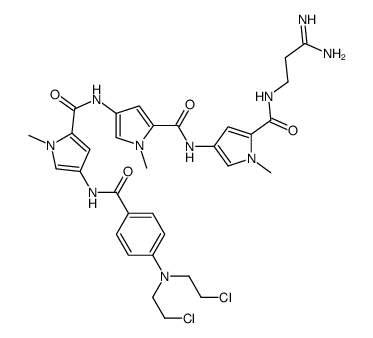Tallimustine
Modify Date: 2024-01-09 17:17:42

Tallimustine structure
|
Common Name | Tallimustine | ||
|---|---|---|---|---|
| CAS Number | 115308-98-0 | Molecular Weight | 697.61500 | |
| Density | 1.41g/cm3 | Boiling Point | N/A | |
| Molecular Formula | C32H38Cl2N10O4 | Melting Point | N/A | |
| MSDS | N/A | Flash Point | N/A | |
| Purity | Quantity | Budget | Inquiry |
|---|
Use of TallimustineTallimustine (FCE 24517), a distamycin-A derivative, is an anticancer agent[1][2][4]. |
| Name | N-[5-[[5-[(3-amino-3-iminopropyl)carbamoyl]-1-methylpyrrol-3-yl]carbamoyl]-1-methylpyrrol-3-yl]-4-[[4-[bis(2-chloroethyl)amino]benzoyl]amino]-1-methylpyrrole-2-carboxamide |
|---|---|
| Synonym | More Synonyms |
| Description | Tallimustine (FCE 24517), a distamycin-A derivative, is an anticancer agent[1][2][4]. |
|---|---|
| Related Catalog | |
| In Vitro | Tallimustine (0.1-10 μM, 4 h) induces damage to purified SV40 DNA[1]. Tallimustine (72 h ) shows cytotoxicity in CEM Cells, with an IC50 of 3.5 nM[1]. Tallimustine (25 and 100 nM, 6 days) induces erythroid differentiation of K562 cells[2]. Tallimustine (100 nM, 6 days) increases accumulation of γ-globin mRNA in K562 cells[2]. Tallimustine (0.5 μg/mL, 1 h) arrests SW626 cells in G2/M phase[3]. Cell Viability Assay[2] Cell Line: K562 cells Concentration: 25 and 100 nM Incubation Time: 4 days Result: Inhibited cell proliferation. |
| In Vivo | Tallimustine (3 mg/kg, i.p.) shows antileukaemic activity in L1210 tumor bearing mice[4]. Animal Model: L1210 tumor bearing mice[2]. Dosage: 3 mg/kg Administration: Intraperitoneal injection (i.p.) Result: Prolonged the survival of mice. |
| Density | 1.41g/cm3 |
|---|---|
| Molecular Formula | C32H38Cl2N10O4 |
| Molecular Weight | 697.61500 |
| Exact Mass | 696.24500 |
| PSA | 184.30000 |
| LogP | 5.20880 |
| Index of Refraction | 1.668 |
| 1H-Pyrrole-2-carboxamide,N-(5-(((3-amino-3-iminopropyl)amino)carbonyl)-1-methyl-1H-pyrrol-3-yl)-4-(((4-((4-(bis(2-chloroethyl)amino)benzoyl)amino)-1-methyl-1H-pyrrol-2-yl)carbonyl)amino)-1-methyl |
| Tallimustine |
| Tallimustine [INN] |